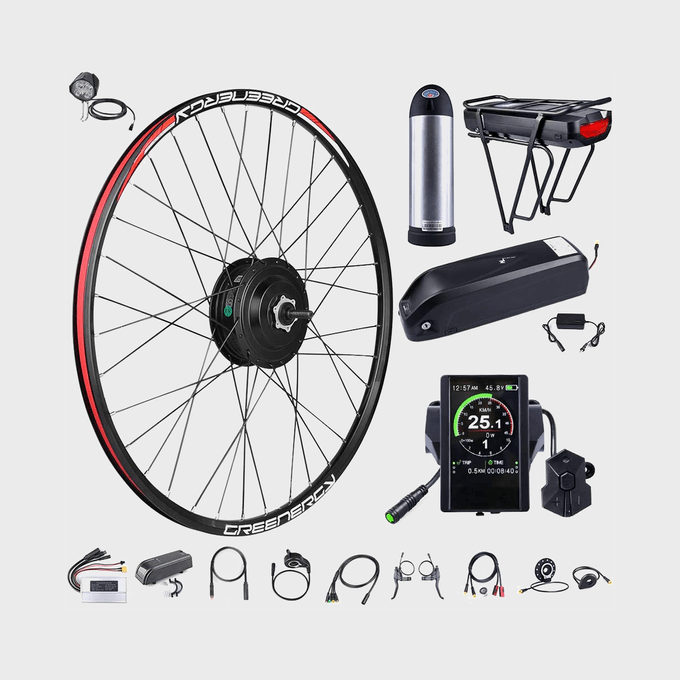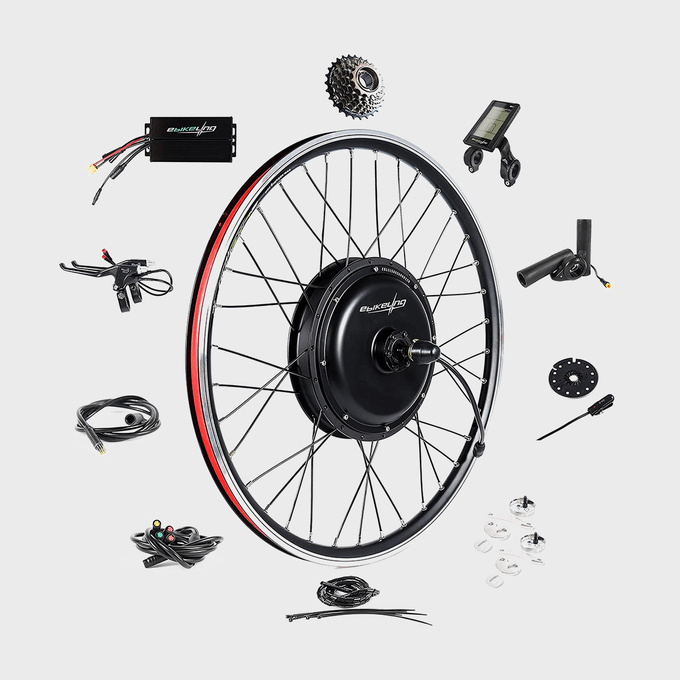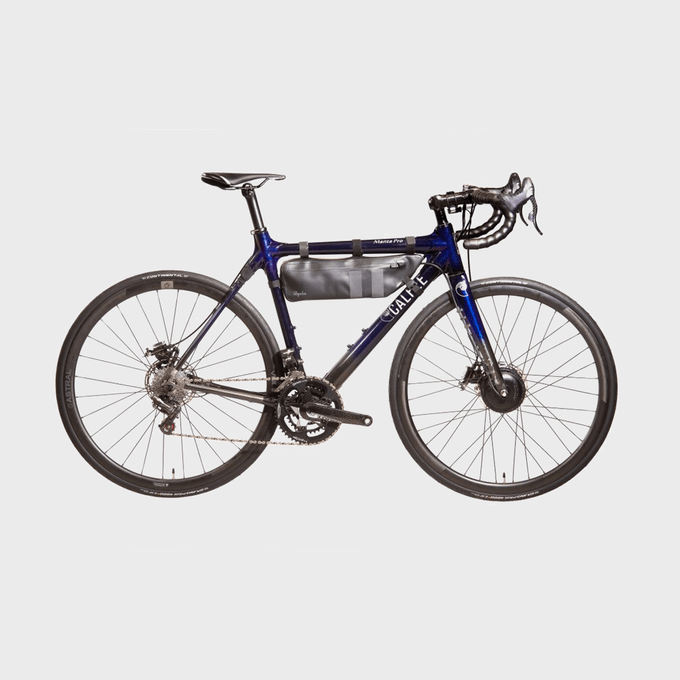The first time I got passed by someone riding an electric bicycle, I quietly cursed the person who zipped by without peddling. “That’s not biking, that’s just being lazy,” I thought. The second time I got passed, I realized I was actually jealous.
Lots of people are embracing the convenience, accessibility and environmental benefits of e-bikes. Cities, such as Denver, are offering rebates to encourage people to buy them. But, buying a brand-new e-bike isn’t the only option. With a conversion kit and a little DIY magic, you can turn your existing peddler into a motorized workhorse.
“The idea of retrofitting a kit to your existing bike is gaining in awareness,” says Craig Calfee, owner of Calfee Design in La Selva Beach, California. “While a new e-bike is a highly engineered and complete product, it also means you are married to that system and the company behind it. On the other hand, a kit allows you to add e-components to your favorite bike, which already fits you well and which you are already used to.”
What Is an E-bike?
An e-bike is a bicycle with an electric motor powered by a rechargeable battery. E-bikes usually include a control panel with a display mounted to the handlebars to show your speed, remaining battery power, and some other useful parameters. Some e-bikes simply assist your pedal power, while others have throttles that allow you to skip peddling altogether. Either way, they allow you to travel farther and faster with less effort.
“E-bikes are so awesome because they can meet so many people’s needs, regardless of who you are,” says Levi Conlow, CEO and co-founder of Lectric eBikes. Plus, “With cars and motorcycles, commuters have to worry about things like insurance policies, registration and gas prices, and it’s easy for the costs to add up. You can avoid all that on an e-bike.”
What Is an E-bike Conversion Kit?
An e-bike conversion kit allows you to convert your bicycle into an e-bike so you can have the benefits of electric power without having to purchase a whole new bike. E-bike conversion kits vary widely in terms of power and quality, but all contain essentially the same components:
- An electric motor;
- A battery;
- A control unit;
- And usually, a display displaying your remaining battery power, assist level, speed and rpm.
There are three types of e-bike kits:
- Hub-drive (AKA hub-motor) systems are powered by a motor encased inside the front or rear wheel hub. These can be added to the front or back wheel and are available in a range of power levels. They are usually the easiest to install and often have regenerative braking, which means that when you brake, some power goes back into the system to re-charge the battery.
- Mid-drive, (AKA bottom-bracket) systems place the motor at the cranks, which is what your pedals attach to. They in turn power the front chain ring and add power to the rear wheel through the chain. “These are preferred for off-road bikes, or if one has long, steep hills to contend with,” says Calfee. The drawbacks of this system include having to change the cranks, greater wear on the drivetrain, incompatibility with many bikes, and only medium and high power levels.
- Manufacturer Bimotal has recently begun making a third type of kit. It’s a removable system that adds power through a special disc-brake rotor. These are so new that they’re not yet widely available, but they will likely be popular for retrofitting newer, high-end mountain bikes.
How to Install an E-Bike Conversion Kit?
The ease of installing an e-bike conversion kit varies widely from kit to kit, but you’ll need some patience, and somewhere between two and six hours of time. We’re giving the process a medium difficulty rating, because it includes installing electrical components. The tools and materials you’ll need to install it are:
- A bike stand, or other secure way to keep your bike stationary;
- Tools to remove your crankset, hub(s) and freewheel (these tools will be specific to your particular bike brand and model);
- Standard pliers;
- Heavy-duty zip ties;
- A set of small screwdrivers.
Some kits come with complete instructions, including YouTube videos and person-to-person help, if questions arise. Others offer little to no customer support. See below for a few recommendations on kits that come with ample instructions and support.
How to Choose the Best E-Bike Kit for your Bike?
One of the most challenging parts of converting your bike to an e-bike is figuring out which kit will fit. Most manufacturers have a helpful list of specifications, which likely includes:
- the width of your front fork or shocks (what your front wheel attaches to);
- the width of your rear frame stays (the back triangle of your frame that your rear wheel attaches to);
- the type of freewheel and cassette you have (the back gears and the cylindrical piece beneath them, that clicks when you’re coasting);
- brake type and configuration;
- wheel diameter and rim dimensions.
To save headaches from an ill-fitting system, make sure all of these details are specified and match your bike before ordering.
Besides finding one that will fit, you’ll also want to consider these features:
- Battery type, voltage and amp hour rating: Ideal specs are a lithium-based 36-volt or 48-volt battery, with a wattage rating between 300 and 600 watts. Look for a minimum rating of 10ah, and keep in mind that battery needs also depend on rider use, weight, terrain and budget.
- Drive location: A front hub motor is usually the easiest to install. A rear hub motor setup is a close second. Mid-drives can be more complex and fit fewer bicycles.
- Warranty and support: Make sure the conversion kit manufacturer is truly reachable by telephone, email or via their site for support and replacement parts.
- Cost. “If they’re just dabbling in the idea, perhaps one of the cheaper kits will be a great way to get into it without spending much money,” says Calfee. “If they really catch the bug, they might want to invest in a higher quality and more reliable kit.”
Three Top E-bike Kits
Most Versatile

Bafang’s 48-volt 500-watt front-hub motor conversion kit is a solid bet for a decent price. It offers sizes and styles to fit most bicycles, gives comprehensive instructions for figuring out if your bike meets their specifications. It also has YouTube videos and customer support if you have questions during installation. You can further tailor the kit to your needs by choosing from an array of batteries, displays and other options. It’s also a good retrofit for older mountain bikes. This kit costs approximately $550 to $700, depending on front vs. rear, wheel size and accessories.
Best Low-Budget

Ebikeling’s waterproof e-bike front- or rear-hub conversion kit hits a nice entry-level price point, while still including a battery and detailing specifications and installation tips. They don’t have official YouTube videos, but people who have purchased them have uploaded some helpful ones. They also offer customer service for questions during installation. This kit costs approximately $390 to $490, depending on wattage.
Best High-End

Calfee Designs custom-make their Electofit kits for your bike. After you fill out their online configuration tool, you’ll get a one-on-one consultation, fitting and installation help from a company that’s been building bikes in California for 30 years. They’ve also been e-converting tandems, recumbents and travel bikes. Prices for Calfee’s conversion kits are approximately $2,500 to $4,000, depending on type, battery and accessories.
Article source here: How To Choose the Best E-Bike Conversion Kit for Your Bike

No comments:
Post a Comment